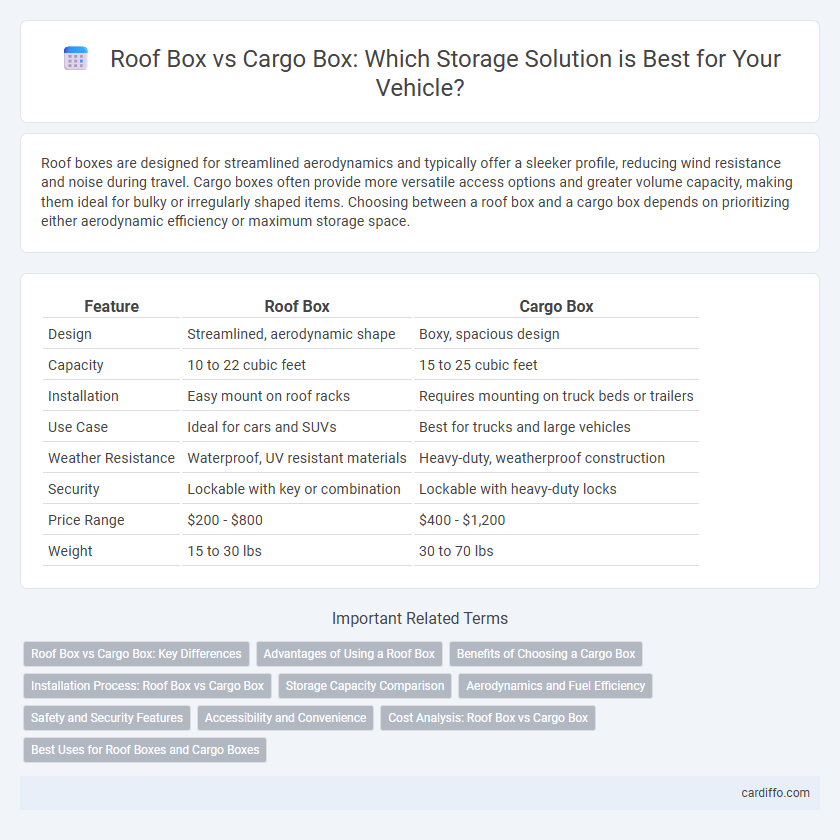Roof boxes are designed for streamlined aerodynamics and typically offer a sleeker profile, reducing wind resistance and noise during travel. Cargo boxes often provide more versatile access options and greater volume capacity, making them ideal for bulky or irregularly shaped items. Choosing between a roof box and a cargo box depends on prioritizing either aerodynamic efficiency or maximum storage space.
Table of Comparison
| Feature | Roof Box | Cargo Box |
|---|---|---|
| Design | Streamlined, aerodynamic shape | Boxy, spacious design |
| Capacity | 10 to 22 cubic feet | 15 to 25 cubic feet |
| Installation | Easy mount on roof racks | Requires mounting on truck beds or trailers |
| Use Case | Ideal for cars and SUVs | Best for trucks and large vehicles |
| Weather Resistance | Waterproof, UV resistant materials | Heavy-duty, weatherproof construction |
| Security | Lockable with key or combination | Lockable with heavy-duty locks |
| Price Range | $200 - $800 | $400 - $1,200 |
| Weight | 15 to 30 lbs | 30 to 70 lbs |
Roof Box vs Cargo Box: Key Differences
Roof boxes are aerodynamic storage solutions mounted on vehicle rooftops, designed to maximize external space without compromising interior seating capacity. Cargo boxes, which can include both rooftop and rear-mounted designs, offer versatile storage options but may vary in accessibility and impact on vehicle aerodynamics. Choosing between roof boxes and cargo boxes depends on factors such as vehicle type, storage volume needs, ease of installation, and travel frequency.
Advantages of Using a Roof Box
Roof boxes provide aerodynamic designs that minimize wind resistance, enhancing fuel efficiency compared to traditional cargo boxes. They offer increased weather protection for belongings, ensuring items remain dry and secure during transit. Roof boxes also typically feature lockable mechanisms, improving security and peace of mind while traveling.
Benefits of Choosing a Cargo Box
Cargo boxes provide superior protection for outdoor gear with durable, weather-resistant materials designed to withstand harsh conditions. Their aerodynamic shapes reduce wind resistance, improving fuel efficiency compared to traditional roof boxes. Enhanced security features like lockable latches ensure belongings remain safe during travel.
Installation Process: Roof Box vs Cargo Box
Roof box installation typically requires mounting crossbars on the vehicle's roof rack, followed by securing the box with clamps or locks designed specifically for the model. Cargo boxes may offer more variety in attachment methods, including straps or quick-release systems, allowing for faster and sometimes tool-free installation. Both systems demand proper alignment and secure fastening to ensure safety, but roof boxes often require a more precise setup to avoid wind noise and maintain aerodynamics.
Storage Capacity Comparison
Roof boxes typically offer greater storage capacity than cargo boxes, with sizes ranging from 12 to 22 cubic feet, suitable for larger luggage and bulky items. Cargo boxes, while generally smaller, provide a compact alternative ranging between 8 to 15 cubic feet, ideal for limited storage needs and easier vehicle handling. Selecting the right option depends on the amount of gear, vehicle compatibility, and desired aerodynamic efficiency.
Aerodynamics and Fuel Efficiency
Roof boxes typically feature streamlined designs with smooth, aerodynamic contours that reduce air resistance, improving fuel efficiency compared to bulkier cargo boxes. Cargo boxes often prioritize spaciousness over shape, resulting in increased drag and higher fuel consumption during travel. Choosing an aerodynamic roof box can lead to fuel savings of up to 10%, especially at highway speeds.
Safety and Security Features
Roof boxes and cargo boxes both enhance vehicle storage but differ in safety and security features. Roof boxes typically feature aerodynamic designs with robust locking mechanisms to prevent theft and secure contents during transit. Cargo boxes often incorporate reinforced materials and tamper-proof locks, ensuring protection against weather and unauthorized access while maintaining vehicle stability.
Accessibility and Convenience
Roof boxes offer enhanced accessibility with side-opening mechanisms that allow users to reach items without unloading the entire box, making them ideal for frequent access during trips. Cargo boxes, often top-loading, provide spacious storage but require unloading to access items at the bottom, which can reduce convenience for quick retrieval. The choice between roof boxes and cargo boxes depends on the balance between accessibility needs and the volume of cargo storage required.
Cost Analysis: Roof Box vs Cargo Box
Roof boxes typically cost between $300 and $700, offering a lightweight and aerodynamic option for extra storage, while cargo boxes range from $500 to $1000, providing more durable materials and larger capacities. Maintenance and installation costs for roof boxes are generally lower due to simpler mounting systems compared to cargo boxes, which may require professional assistance. Considering long-term investment, roof boxes provide better fuel efficiency, but cargo boxes offer higher durability and protection, justifying the higher upfront price for frequent use.
Best Uses for Roof Boxes and Cargo Boxes
Roof boxes are ideal for aerodynamic storage of long items like skis and snowboards, maximizing vehicle rooftop space without compromising fuel efficiency. Cargo boxes excel in carrying bulky gear such as camping equipment, luggage, and sports gear, offering weather-resistant protection for extended trips. Both options enhance storage capacity while preserving interior passenger space, tailored to specific travel needs and vehicle types.
roof box vs cargo box Infographic

 cardiffo.com
cardiffo.com